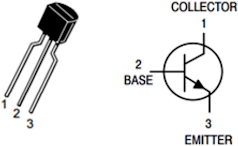Lesson 2 - White noise generator

I decided to try following synthnerd's blog to create a white noise generator. It worked! In the process, I learned several things. NPN bipolar junction transistors (BJT) As a brief recap, here's an illustration of an NPN transistor (the position of collector and emitter may be swapped in some models, always check the datasheet *and* with the tester in the multimeter): The collector-to-emitter path conducts only if there is some positive current at the base (very few mA are sufficient); further, the voltages must satisfy $V_C>V_B>V_E$. Once the transistor conducts, one gets an amplified current $I_C \gg I_B$ and then $I_E = I_C+I_B \approx I_C$. At this point, I thought one would put the load at the emitter; however, in all the examples I have seen so far, people ground the emitter and connect the load to the collector. This seems to be called the common emitter configuration , where "common" here means "ground". Reverse bias leads to electrical brea...